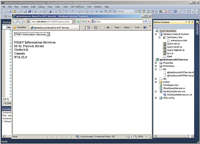Product Reviews
Client-Side Data Management with NetAdvantage for jQuery
Infragistics provides a toolkit for creating data-driven applications using client-side code that accesses a variety of data sources, both in the page and back on the client.
The primary focus of NetAdvantage for jQuery is a set of extensions to the open source JavaScript library for creating data-driven applications that can access data on the server (through services) or embedded in the page. But, in some ways, NetAdvantage for jQuery is an odd package. Infragistics has included several non-client, .NET, server-side resources: libraries for managing XPS and PDF documents and for working with both Word and Excel files. Other components that go beyond jQuery are a better fit for the product's title -- namely, a set of ASP.NET MVC helpers to facilitate generating client-side code for jQuery extensions, and the necessary libraries to integrate the extensions into ASP.NET MVC applications.
But what a developer is looking for in a client-side jQuery package are JavaScript libraries that extend jQuery. Here, the jewel in the crown is the Infragistics igDataSource control. The igDataSource, similar to the ASP.NET DataSources, makes a variety of data look alike. With the igDataSource, you can retrieve data from Web Services (returning JSON or XML), RESTful services, arrays, HTML tables and most of the client-side objects holding data that you'd want to display. This flexibility lets you create pages that combine a variety of data sources into a single display. The igDataSource can cache data locally so that you can provide filtering and sorting at the client. A simple call to the igDataSource SaveChanges method pushes changes back to the data source (where the data source supports updating).
While the igDataSource is the key part of the package, jQuery for NetAdvantage also includes almost a dozen editing controls, including a grid, a text editor, a date editor and a date picker, an upload control and a video player. The controls will be familiar to anyone used to working with jQuery UI Widgets. Styling support is based on the jQuery UI CSS Framework and can use themes generated by the jQueryThemeRoller tool. The package also includes support for accessibility and internationalization.

[Click on image for larger view.] |
| Creating a Grid: In this simple page, the drop-down list is loaded from the server, but when the user selects an entry the grid is loaded from client-side code using the igDataSource and igGrid.
|
Installation was easy: I just downloaded the package from the Infragistics site and ran the installerEXE file to install everything. If you'd prefer not to add the Infragistics JavaScript libraries to your application, you can use the company's Content Delivery Network.
No documentation is installed on your computer or integrated into the Visual Studio help system. You'll find a link to documentation in your Windows Start menu (once you drill down far enough) that leads to the general introduction to all of the Infragistics help and related resources. After finding the help for the package, you'll want to add two bookmarks to your browser: one for the developer's guide and another to the API documentation. Several demos are included in the download, but for direction on using them with ASP.NET MVC, ADO.NET Data Services or Windows Communication Foundation .svc files in an ASP.NET application, you'll need to visit the Infragistics Web site. Infragistics provides a trial download so that you can make sure you're comfortable working with the package before buying it.
NetAdvantage for jQuery
Infragistics Inc.
Web: Infragistics.com
Phone: 800-231-8588
Price: $995; $1,495 with Priority Support
Quick Facts: A set of JavaScript libraries that includes a dozen jQuery extensions aimed at managing data
Pros: Includes a client-side data source manager, a grid and a range of editors for accepting data
Cons: Help support not well integrated
About the Author
Peter Vogel is a system architect and principal in PH&V Information Services. PH&V provides full-stack consulting from UX design through object modeling to database design. Peter tweets about his VSM columns with the hashtag #vogelarticles. His blog posts on user experience design can be found at http://blog.learningtree.com/tag/ui/.